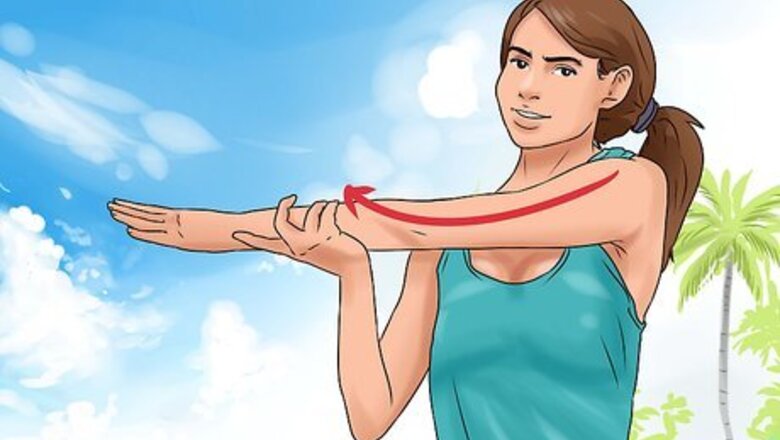
views
X
Expert Source
Ashley Mak, DPTPhysical Therapist
Expert Interview. 3 March 2020.
Regardless of the cause, knots in shoulder muscles can be worked with specific home care or with the help of musculoskeletal specialists.
Working Out Knots at Home
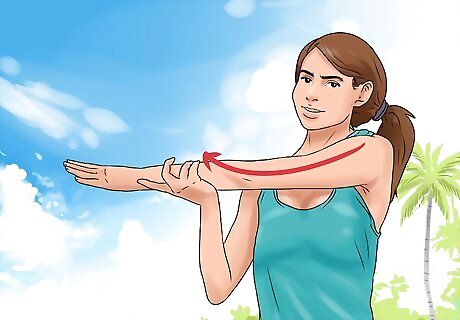
Do some light stretching. Muscle knots are basically chronic muscle strains caused by repetitive movements or postures that contract muscle fibers for long periods of time. Muscles are meant to contract for short durations, then completely relax. However, performing similar movements over and over (due to athletics, weightlifting, cleaning the house, etc.) or sustaining certain postures while at work strains muscles fibers and causes them to remain contracted. As such, chronic muscle strains and knots respond well to light stretching because it relieves the tension, promotes blood flow and improves flexibility. As a general rule, hold the stretches (without bouncing) for about 30 seconds and do them at least three times daily until the achiness from the knot fades away. While standing or sitting up straight, reach around the front of your body and grab the opposite arm with your hand - around the elbow area, but never apply force to a joint, as this can cause damage. Gently pull on the back of the arm across your chest until you feel a stretch in the corresponding shoulder. Be sure to drop your shoulder away from your ear (don't hike it up). This stretch is great for the outer and rear muscles of the shoulder. While standing or sitting up straight, reach behind your back and grab the wrist of the other hand (the one with the shoulder knot). Slowly pull down on your arm just above the wrist - avoiding grabbing the joint - until you feel a good stretch in the affected shoulder. This stretch is great for shoulder muscles that attach to your neck. To increase the stretch, you can drop your ear towards the opposite shoulder
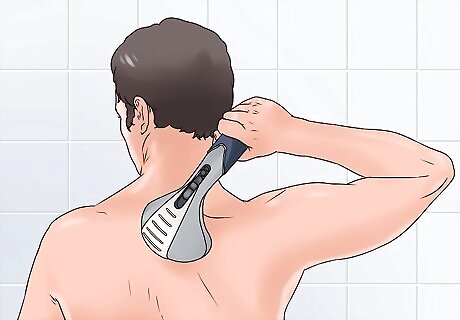
Use a handheld massager. Feeling for a knot in larger muscles like those in the shoulder is not too difficult. The knot should feel harder than the surrounding tissue and get achy with applied pressure. Unlike acute muscle injuries, there likely won't be obvious evidence of inflammation, swelling or redness. So feel around your shoulder and locate the knot, which is also called a trigger point. Once found, use a handheld vibrating massager over the knot for 5 to 10 minutes and see if that works the knot out. You may need to apply more pressure for longer periods of time for noticeable results. Although handheld massagers are commonly found in pharmacies and usually inexpensive, you can also use handheld wooden massage devices for working out knots. They may require more exertion, but they typically cost less.
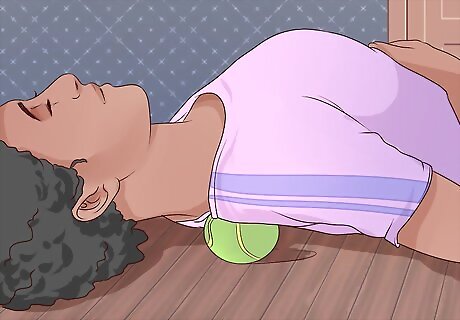
Use a tennis ball. If your shoulder knot is closer to your shoulder blade and difficult to reach, then consider using a tennis ball to roll on. Place a tennis ball right beneath your knot and lie directly on it for about five minutes or so. This may be uncomfortable at first, but you should feel the knot slowly melt away. EXPERT TIP Eric Christensen, DPT Eric Christensen, DPT Physical Therapist Eric Christensen is a Physical Therapist based in Chandler, Arizona. With over a decade of experience, Eric works in both orthopedic and neurological fields and specializes in custom orthotic prescription and casting, vestibular reprogramming, and manual therapy. He holds a Bachelor’s degree in Exercise Science with a focus in Sports Medicine from Colorado State University and a Doctor of Physical Therapy from Regis University. In practice, Eric takes a developmental approach to rehabilitation utilizing the Selective Functional Movement Assessment. He uses functional movement patterning and manual therapy to return patients to prior levels of function. Eric Christensen, DPT Eric Christensen, DPT Physical Therapist A ball can massage your sore shoulders. Shoulder tightness can often be helped with a simple self-massage using a tennis or lacrosse ball. Lean your shoulder blade against a wall, then sandwich the ball between the wall and the sore spot for 30 seconds to release tension.
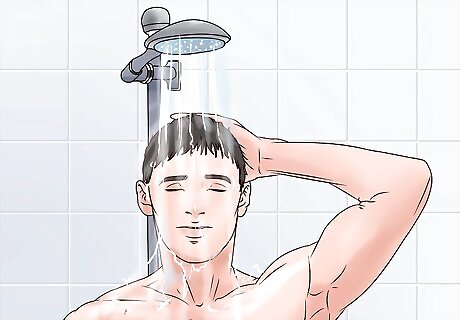
Apply some moist heat. As noted above, muscle knots are a type of chronic injury and don't typically involve inflammation and sharp pain like acute muscle injuries do. As such, applying ice to muscle knots is not appropriate because you actually want more blood flow. Instead, apply moist heat to your shoulder muscle knot. Moist heat warms up the soft tissues (muscles, tendons and ligaments) and increases blood flow, which can be helpful for chronically tight muscles and knots. Great sources of moist heat include microwavable bags filled with grains (usually wheat or rice), herbs and/or essential oils. Warm the bag in the microwave for about two minutes or so and then apply the moist heat to the muscle knot for about 15 minutes at least three times daily. Applying moist heat before exercise can help reduce muscle tension and pain, and also increase tissue extensibility. Taking a warm bath also provides your muscles with moist heat. Try adding some Epsom salt (which is rich in magnesium) for even more muscle relaxing potential. Avoid applying dry heat from traditional heating pads because it dehydrates soft tissues and increases the risk of further injury. If your gym has a steam room, try spending some time relaxing there, as this is another good source of moist heat.
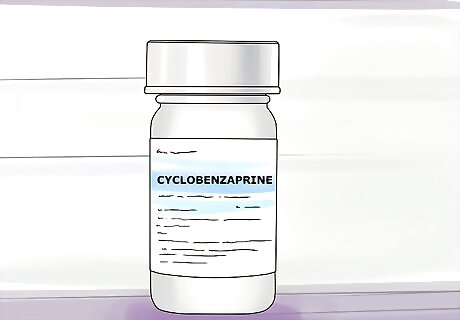
Take some over-the-counter medication. Muscle relaxants (such as cyclobenzaprine) can be helpful for muscle spasms and knots because they release the tension in muscles. However, when you take medications orally (through the mouth) their effects are not limited to the problematic area. As such, muscle relaxants can cause strange sensations in some users because they reduce muscle contractions throughout the body. If your muscle knot is particularly achy, then non-steroidal anti-inflammatories (NSAIDs) such as ibuprofen, naproxen or aspirin might be more effective and cause fewer side effects. Some of these medications can be hard on your stomach, kidneys and liver, so it's best not to take them for more than two weeks. Regardless, of what type of medication you choose, take them on a full stomach. Always follow the instructions on the medication's package or ask your doctor for clear instructions on the appropriate dosing regimen. Try applying a pain-relieving cream such as Icy-Hot or Bengay directly over the problem area.
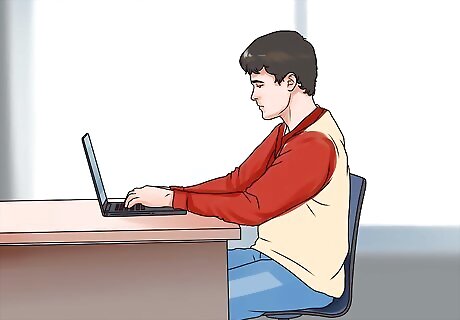
Examine your work area. If your shoulder knot is obviously not caused by playing sports or working out, then consider how your workstation/desk might be involved. For example, if your computer, desk or chair isn't positioned properly for your size it can put strain on your shoulders, neck and mid-back (between your shoulder blades). While sitting at your desk and looking straight ahead your eyes should be level with the top 1/3 of your monitor; your forearms should be close to parallel with the floor when typing and supported by stable armrests; your elbows should be within a few inches from your sides; and your feet should be placed flat on the floor. If your arm position is too high or low due to the level of your desk or chair, then your risk of shoulder problems is greater. To prevent shoulder strain, minimize overhead work by using a taller ladder or getting closer to your task. Don't cradle the phone between your neck and shoulder. Use a headset or speakerphone setting instead. If you spend a lot of time in the car commuting, this may contribute to your shoulder pain. Try keeping your hands low on the steering wheel with your palms downwards.
Getting Professional Care for Shoulder Knots
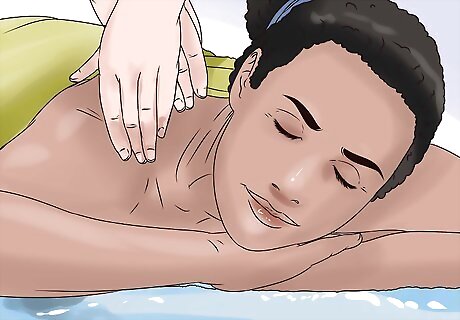
Get a professional massage. If using a vibrating massager or tennis ball is ineffective at working out your shoulder knot, then consider seeing a professional massage therapist. A deep tissue massage is helpful for chronic strains and knots because it reduces muscle spasm and tension, stimulates blood circulation and promotes relaxation. Start with a 30-minute massage session, focusing on your sore shoulder and surrounding areas (lower neck and mid back). Allow the massage therapist to go as deep into the muscle fibers as you can tolerate. The massage therapist may do some trigger point therapy, which involves pressing a thumb or tip of an elbow into the knot to get the muscle fibers to release. It can be painful but effective, so trust in the therapist's experience and knowledge. Always drink lots of purified water immediately following a massage so that any inflammatory by-products and lactic acid is flushed out of your body. Failure to do so might result in a mild headache or soreness the next day.
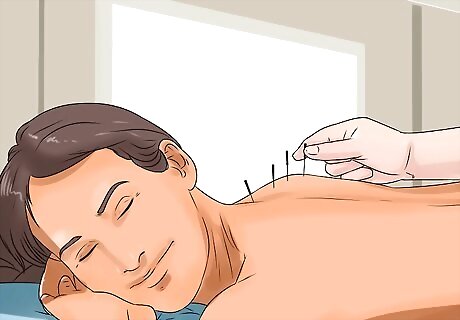
Consider an acupuncture treatment. Acupuncture is an ancient healing technique that involves sticking thin needles into specific points within the skin / muscle in efforts to reduce pain and promote healing. The procedure is not particularly painful because it triggers the release of natural painkillers (called endorphins) and treatments last anywhere from 15 – 45 minutes for most musculoskeletal problems. Acupuncture for shoulder injuries can be very effective, especially if it's done shortly after you notice the symptoms. A single acupuncture treatment may not completely get rid of your shoulder knot, so consider at least three treatments before your render judgement on its effectiveness. Keep in mind that the acupuncture points that can relieve your muscle knot are not all located in the shoulder — some can be in distant areas of the body. Acupuncture is practiced by a wide variety of medical professionals including some physicians, chiropractors, naturopaths and physiotherapists — whoever you choose should be NCCAOM certified.
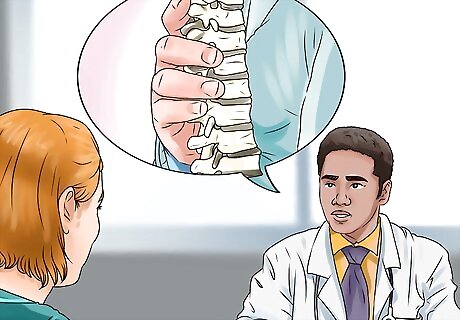
Make an appointment with a chiropractor. Chiropractors are musculoskeletal specialists who focus on establishing normal motion and function within muscles and joints of the spine and related areas, such as the shoulder. If your shoulder knot is closer to your shoulder blade or neck, then there's a good chance that your mid-back or neck is also involved. A chiropractor is trained in manual techniques to stretch tight muscles, release knots and adjust involved joints. Joint adjustments often elicit "popping" or "cracking" sounds, which aren't painful. An interesting sequel of a joint adjustment is that it relaxes all surrounding / related muscles almost immediately Although one chiropractic treatment can sometimes completely dissolve your shoulder knot, it's likely that a few treatments will be needed to notice significant results. Other medical professionals who perform joint adjustments include some Doctors of Osteopathic Medicine (DO) (also known as osteopathic physicians), Doctors of Medicine (MD), physiotherapists, and non-physician osteopaths. Health insurance policies do not all cover chiropractic services, so you may have to pay out of pocket for treatments.
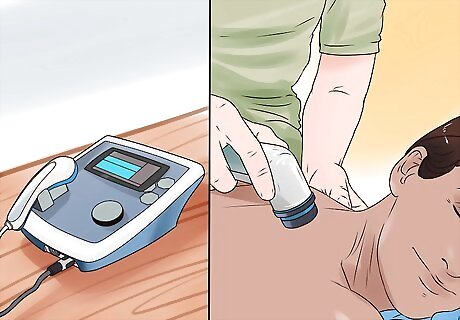
See a physiotherapist. If your shoulder knot is not resolved with home care, professional massage therapy or chiropractic treatments, then you need to consider some form of shoulder rehabilitation guided by a physiotherapist. Your family physician can refer you to a physiotherapist, who can show you specific stretches and strengthening exercises to rehabilitate your involved shoulder muscles. The therapist may utilize machines, free weights, rubber bands and/or exercise balls to strengthen your shoulder so it can withstand the rigors of your sport or work environment. Physiotherapists are also trained to treat muscle knots with therapeutic ultrasound or electronic muscle stimulation if necessary. Physical rehabilitation is typically required 2-3x per week for 4-8 weeks to significantly impact chronic shoulder issues. Good general strengthening activities for your shoulders include rowing, swimming, push-ups and pull-ups.










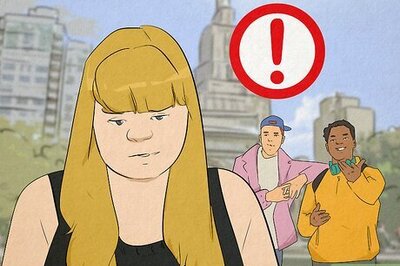








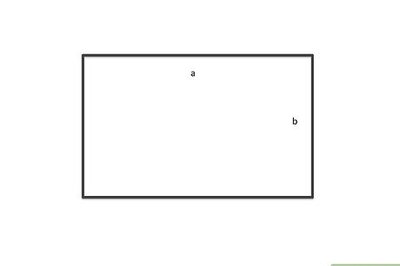
Comments
0 comment